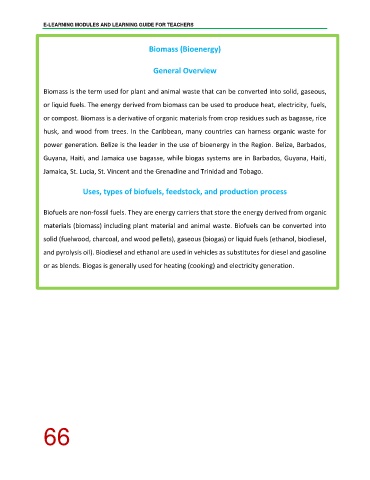Page 68 - “GREENING” THE CONTENT IN CXC® SYLLABUSES
P. 68
E-LEARNING MODULES AND LEARNING GUIDE FOR TEACHERS
Biomass (Bioenergy)
General Overview
Biomass is the term used for plant and animal waste that can be converted into solid, gaseous,
or liquid fuels. The energy derived from biomass can be used to produce heat, electricity, fuels,
or compost. Biomass is a derivative of organic materials from crop residues such as bagasse, rice
husk, and wood from trees. In the Caribbean, many countries can harness organic waste for
power generation. Belize is the leader in the use of bioenergy in the Region. Belize, Barbados,
Guyana, Haiti, and Jamaica use bagasse, while biogas systems are in Barbados, Guyana, Haiti,
Jamaica, St. Lucia, St. Vincent and the Grenadine and Trinidad and Tobago.
Uses, types of biofuels, feedstock, and production process
Biofuels are non-fossil fuels. They are energy carriers that store the energy derived from organic
materials (biomass) including plant material and animal waste. Biofuels can be converted into
solid (fuelwood, charcoal, and wood pellets), gaseous (biogas) or liquid fuels (ethanol, biodiesel,
and pyrolysis oil). Biodiesel and ethanol are used in vehicles as substitutes for diesel and gasoline
or as blends. Biogas is generally used for heating (cooking) and electricity generation.
66

